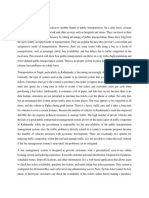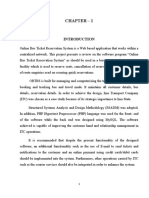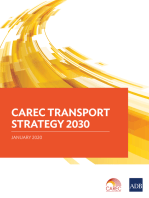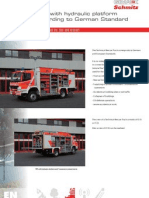0 ratings0% found this document useful (0 votes)
11 viewsAnswer Case 2
Answer Case 2
Uploaded by
Ngọc Bích Vũ ThịThe document discusses innovative credit card micropayments for the Korean Metropolitan Unified Fare System. It discusses how credit cards can be processed as quickly as stored-value cards, the benefits of credit-based transportation cards for commuters and governments, and how the Metropolitan Unified Fare System enables restructuring of public transportation infrastructure.
Copyright:
© All Rights Reserved
Available Formats
Download as DOCX, PDF, TXT or read online from Scribd
Answer Case 2
Answer Case 2
Uploaded by
Ngọc Bích Vũ Thị0 ratings0% found this document useful (0 votes)
11 views2 pagesThe document discusses innovative credit card micropayments for the Korean Metropolitan Unified Fare System. It discusses how credit cards can be processed as quickly as stored-value cards, the benefits of credit-based transportation cards for commuters and governments, and how the Metropolitan Unified Fare System enables restructuring of public transportation infrastructure.
Original Title
answer case 2
Copyright
© © All Rights Reserved
Available Formats
DOCX, PDF, TXT or read online from Scribd
Share this document
Did you find this document useful?
Is this content inappropriate?
The document discusses innovative credit card micropayments for the Korean Metropolitan Unified Fare System. It discusses how credit cards can be processed as quickly as stored-value cards, the benefits of credit-based transportation cards for commuters and governments, and how the Metropolitan Unified Fare System enables restructuring of public transportation infrastructure.
Copyright:
© All Rights Reserved
Available Formats
Download as DOCX, PDF, TXT or read online from Scribd
Download as docx, pdf, or txt
0 ratings0% found this document useful (0 votes)
11 views2 pagesAnswer Case 2
Answer Case 2
Uploaded by
Ngọc Bích Vũ ThịThe document discusses innovative credit card micropayments for the Korean Metropolitan Unified Fare System. It discusses how credit cards can be processed as quickly as stored-value cards, the benefits of credit-based transportation cards for commuters and governments, and how the Metropolitan Unified Fare System enables restructuring of public transportation infrastructure.
Copyright:
© All Rights Reserved
Available Formats
Download as DOCX, PDF, TXT or read online from Scribd
Download as docx, pdf, or txt
You are on page 1of 2
INNOVATIVE CREDIT CARD MICROPAYMENTS FOR THE KOREAN
METROPOLITAN UNIFIED FARE SYSTEM
1.How can credit cards be processed as quickly as stored-value cards at the ticket
gate?
In order to pay transportation fares quickly, credit card payments for subways and
buses must be processed without the full authorization procedure.. After that,The
credit-based transportation card has revolutionized the recharge service process. In the
early stage, both MRT cards and bus cards had to be recharged at manned booth.
Then the transportation card, credit or stored-value, is designed to memorize the
departure time from the MRT station that save time.
To sum up To process credit cards as quickly as stored-value cards at the ticket gate,
there are a few factors to consider. Firstly, the speed of processing depends on the
technology used for card transactions.Additionally, optimizing the payment
infrastructure and network connectivity can help reduce processing time.
2. What is the major benefit of owning a credit-based transportation card for
commuters?
-Quick payment.
-Processing does not require authorization procedures.
-Easily move by route and time.
-Integrates many utilities.
3.What is the major benefit of credit-based transportation cards to the city
government?
The major benefit of credit-based transportation cards to the city government is the
ability to collect data about commuters, which can be used to dispatch additional
buses depending on passenger load by route and time. Additionally, the control
center can analyze mobile phone usage in certain areas at midnight to estimate
potential commuters and dynamically determine routes for midnight buses. The
adoption of a Metropolitan Unified Fare System in 2009 has also led to nationwide
standardization and integration of transportation cards using smart cards, allowing
for easier payment services for customers. Overall, credit-based transportation cards
have revolutionized the recharge service process and restructured the city's
transportation system by aligning and coordinating bus and subway routes.
4.How can the Metropolitan Unified Fare System enable the restructuring of
public transportation infrastructure?
The habit of people living and working in Seoul ,Korea depend on public transport
for their mobility and therefore public transport is a key element of Seoul transport
association. However, as identified there are a number of inherent challenges and
constraints with the current system that will be exacerbated as the city grows and the
demand for travel increases. These principally relate to poor and inefficient network
design and capacity, inadequate service levels and quality, particularly poor
reliability, inadequate public transport infrastructure provision, fare level and
structure issues, and inherent constraints with the institutional, regulatory, and
organisational aspects of the public transport sector. Through the transport
association process there is a great opportunity to plan an effective and sustainable
public transport system looking towards 2035, through integrated land use planning
and synergies with other sectors including traffic management and highways.
You might also like
- Sprinter ScheduleDocument1 pageSprinter Schedulepetermcleod1170% (1)
- Apu RMCTDocument10 pagesApu RMCTAiman Bin IdrisNo ratings yet
- Ace Hotel Teaser BrochureDocument16 pagesAce Hotel Teaser BrochureSky YimNo ratings yet
- Case Study 2Document2 pagesCase Study 2tgnghiemtanphongNo ratings yet
- Credit CardDocument2 pagesCredit CardtgnghiemtanphongNo ratings yet
- E-Commerce Assignment - Shahena Saleem Shaikh - Division BDocument4 pagesE-Commerce Assignment - Shahena Saleem Shaikh - Division BShahenaNo ratings yet
- Case Credit CardDocument2 pagesCase Credit CardtgnghiemtanphongNo ratings yet
- E-Payment - Case 2Document3 pagesE-Payment - Case 2Ngọc Bích Vũ ThịNo ratings yet
- Assignment EC 11.1Document2 pagesAssignment EC 11.1Mehwish AnsariNo ratings yet
- SRSDocument11 pagesSRSreshab choudhury100% (1)
- Convenience and Simplicity For The CommuterDocument10 pagesConvenience and Simplicity For The CommuterKe LopezNo ratings yet
- Yallu Kranti ReportDocument42 pagesYallu Kranti ReportAnurag SinghNo ratings yet
- (PPR) SMART BUS-PASS SYSTEM USING QR CODEDocument5 pages(PPR) SMART BUS-PASS SYSTEM USING QR CODEVikas GuptaNo ratings yet
- Final Documentation For SystemDocument30 pagesFinal Documentation For SystemJM GereroNo ratings yet
- Railway Reservation System BlessDocument12 pagesRailway Reservation System Bless727822tucs161No ratings yet
- Android Local Train Tickiting SystemDocument16 pagesAndroid Local Train Tickiting Systemuniqueg892No ratings yet
- Cloud Based Bus Pass System Using Internet of ThingsDocument4 pagesCloud Based Bus Pass System Using Internet of ThingsNadeesha AbeysekaraNo ratings yet
- Online Bus Monitoring and Reservation Application (OBMRA) For GL Trans AgencyDocument7 pagesOnline Bus Monitoring and Reservation Application (OBMRA) For GL Trans AgencyIJELS Research JournalNo ratings yet
- Smart E-Ticketing System For Public Transport BusDocument17 pagesSmart E-Ticketing System For Public Transport BusManojNo ratings yet
- A Proposed Adaption and Readiness Assessment of Cashless Transportation Fare For Public Utility Vehicles in Cebu CityDocument29 pagesA Proposed Adaption and Readiness Assessment of Cashless Transportation Fare For Public Utility Vehicles in Cebu Cityjovbensherjad.lacaba.20No ratings yet
- Nhóm 6 - Hồ Nguyễn Phương Anh - IELSIU20252 - Thầy Phan Nguyễn Kỳ PhúcDocument13 pagesNhóm 6 - Hồ Nguyễn Phương Anh - IELSIU20252 - Thầy Phan Nguyễn Kỳ Phúcgiangtran.89224020022No ratings yet
- Bus UML DIAGRAM-P176 AbstractDocument10 pagesBus UML DIAGRAM-P176 AbstractI NoNo ratings yet
- FOREIGN and LOCAL LITERATUREDocument2 pagesFOREIGN and LOCAL LITERATURECire MalasmasNo ratings yet
- Online Bus Ticket Reservation SystemDocument18 pagesOnline Bus Ticket Reservation SystemChakku ParuNo ratings yet
- Route SyncDocument14 pagesRoute SyncSridhar SivakumarNo ratings yet
- Ali Reza Rezaie ProposalDocument10 pagesAli Reza Rezaie ProposalSayed jawed HossainiNo ratings yet
- Cloud Based Bus Pass SystemDocument9 pagesCloud Based Bus Pass SystemIT PARTHASARATHI BNo ratings yet
- ISSE System Proposal Group 5 IE 4BDocument38 pagesISSE System Proposal Group 5 IE 4BThea PradoNo ratings yet
- Project Title: Online Toll Payment System (Otops)Document2 pagesProject Title: Online Toll Payment System (Otops)Syafiqa SoffiyaNo ratings yet
- UTS Abstract G23Document10 pagesUTS Abstract G23priyachoudhary1No ratings yet
- Survey On Smart Taxi Booking System Ijariie18646Document4 pagesSurvey On Smart Taxi Booking System Ijariie18646Soressa HassenNo ratings yet
- Group 09 - Long Distance Bus Tracking and Booking System Project ProposalDocument10 pagesGroup 09 - Long Distance Bus Tracking and Booking System Project Proposalkeshan kariyavasamNo ratings yet
- Transportation and Ticket Booking PROJECT WORKDocument12 pagesTransportation and Ticket Booking PROJECT WORKGyeabour ChristianNo ratings yet
- Programming Project ProposalDocument8 pagesProgramming Project ProposalnhitnagelnhielzyNo ratings yet
- 45IJMTST1002091Document7 pages45IJMTST1002091khanna.d2003No ratings yet
- Inba - Info - Bus Ticket Reservation System PDFDocument26 pagesInba - Info - Bus Ticket Reservation System PDFRohit ChavanNo ratings yet
- Railway Online BookingDocument38 pagesRailway Online BookingsupreetNo ratings yet
- Bus Ticket Reservation SystemDocument26 pagesBus Ticket Reservation SystemWhambi Enock50% (6)
- System ConceptDocument6 pagesSystem ConceptMackenry Kevin ArcenoNo ratings yet
- Keke Napep Booking SystemDocument22 pagesKeke Napep Booking Systemibrex29No ratings yet
- Minh ThongDocument3 pagesMinh ThongtgnghiemtanphongNo ratings yet
- Metro Train Smartcard Management SystemDocument60 pagesMetro Train Smartcard Management SystemAnantvikramaditya RaikarNo ratings yet
- THESIS Introduction Aim and Objectives PartDocument2 pagesTHESIS Introduction Aim and Objectives PartSushmita DevkotaNo ratings yet
- Automated Toll Collection Using Satellite NavigationDocument3 pagesAutomated Toll Collection Using Satellite NavigationInternational Journal of computational Engineering research (IJCER)No ratings yet
- Transparency in The Functioning of RailwaysDocument10 pagesTransparency in The Functioning of Railwayslakkojiprasanth30No ratings yet
- Engg Econ FinalDocument11 pagesEngg Econ FinalChristiane YambaoNo ratings yet
- Visvesvaraya Technological University: Bus Reservation SystemDocument5 pagesVisvesvaraya Technological University: Bus Reservation Systemaishwarya kulkarniNo ratings yet
- Bus Ticket Reservation SystemDocument28 pagesBus Ticket Reservation Systemnsplatha86% (7)
- Buses and New Fare Payment System - Letter To MTA 6-9-16Document3 pagesBuses and New Fare Payment System - Letter To MTA 6-9-16David MeyerNo ratings yet
- It Sector ApplicationDocument15 pagesIt Sector ApplicationNaresh Chandra PokhriyalNo ratings yet
- Advanced Transport Management SystemDocument3 pagesAdvanced Transport Management SystemEditor IJRITCCNo ratings yet
- Mini ReportDocument29 pagesMini ReportShaikNo ratings yet
- Automated Bus Ticket Reservation System For Ethiopian Bus Transport SystemDocument7 pagesAutomated Bus Ticket Reservation System For Ethiopian Bus Transport SystemLiban ToleraNo ratings yet
- Development of An Online Bus Ticket ReseDocument10 pagesDevelopment of An Online Bus Ticket ReseBay AlemuNo ratings yet
- Public Transportation Automated Fare Collection Systems DesignDocument7 pagesPublic Transportation Automated Fare Collection Systems DesignMehak ChhabraNo ratings yet
- Automated Ticketing SystemDocument24 pagesAutomated Ticketing SystemUdara SeneviratneNo ratings yet
- GMS Transport Sector Strategy 2030: Toward a Seamless, Efficient, Reliable, and Sustainable GMS Transport SystemFrom EverandGMS Transport Sector Strategy 2030: Toward a Seamless, Efficient, Reliable, and Sustainable GMS Transport SystemNo ratings yet
- Improving Interchanges: Toward Better Multimodal Railway Hubs in the People's Republic of ChinaFrom EverandImproving Interchanges: Toward Better Multimodal Railway Hubs in the People's Republic of ChinaNo ratings yet
- 1 Was Viana Still A Passenger During The Time of The Accident, Thus Making Aboitiz Liable For His Death?Document24 pages1 Was Viana Still A Passenger During The Time of The Accident, Thus Making Aboitiz Liable For His Death?Kresnie Anne BautistaNo ratings yet
- Escalator: Model Sizes and Other SpecificationsDocument7 pagesEscalator: Model Sizes and Other SpecificationsNur Ain IkhwanNo ratings yet
- IRECN Bridge Bearing-1Document20 pagesIRECN Bridge Bearing-1vpmohammed100% (1)
- Route 900 - HOLIDAY SCHEDULEDocument2 pagesRoute 900 - HOLIDAY SCHEDULESomeguy95No ratings yet
- Report On PavilionDocument23 pagesReport On PavilionRoshini Ganesh KumarNo ratings yet
- How To Get To Goldsmiths: by TrainDocument2 pagesHow To Get To Goldsmiths: by TraingimenaNo ratings yet
- Nadya KomonaciDocument62 pagesNadya Komonaciaykut1324No ratings yet
- Im EditingDocument79 pagesIm EditingJulius EdillorNo ratings yet
- Model RailwaysDocument2 pagesModel RailwaysKavindu H. PereraNo ratings yet
- KDP To Pune TrainsDocument10 pagesKDP To Pune TrainsPradeep KumarNo ratings yet
- 004 Fairmate - Product Information GuideDocument32 pages004 Fairmate - Product Information Guidefairmatechemical100% (1)
- RSSB Structures and Earthworks Rules Changes Briefing For DriversDocument9 pagesRSSB Structures and Earthworks Rules Changes Briefing For DriversIsmail Ibn HashimNo ratings yet
- Metro Study PDFDocument24 pagesMetro Study PDFGeorge K GeorgeNo ratings yet
- Comprehension ExtractsDocument9 pagesComprehension Extractsmarijana_jovanovikNo ratings yet
- Chap - 17Document12 pagesChap - 17dcf67myNo ratings yet
- Skybus Tecnology: Bachelor of TechnologyDocument21 pagesSkybus Tecnology: Bachelor of TechnologyAbhimanyu Singh Bhati100% (3)
- E Project09 FullDocument137 pagesE Project09 Fullરામ પ્રતાપNo ratings yet
- Ticket For Hebbal Opp To Ps-Hyderabad MgbsDocument1 pageTicket For Hebbal Opp To Ps-Hyderabad Mgbs7athirah9No ratings yet
- 1379060370636-GSR Manual PDFDocument564 pages1379060370636-GSR Manual PDFMoon Honey100% (1)
- Introduction To Hospitality Fifth Edition John R. Walker: Chapter 2: TourismDocument34 pagesIntroduction To Hospitality Fifth Edition John R. Walker: Chapter 2: TourismZohaib ChandioNo ratings yet
- Dawes and Homestead Act Webquest 2017Document4 pagesDawes and Homestead Act Webquest 2017api-262890296No ratings yet
- English Class Beginner - IsA UGM 2Document2 pagesEnglish Class Beginner - IsA UGM 2donnaNo ratings yet
- SC To BZA TICKET TRAINDocument2 pagesSC To BZA TICKET TRAINcsvarma424No ratings yet
- Train Booking Invoice - KoiceDocument2 pagesTrain Booking Invoice - Koicefopines281No ratings yet
- New York State and Municipal Facilities Program Project NominationDocument1,416 pagesNew York State and Municipal Facilities Program Project NominationNew York Senate100% (1)
- ST5015-Design of BridgesDocument14 pagesST5015-Design of BridgesNarayanan MoorthyNo ratings yet
- Gimaex TRT With Hydraulik Platform - 14208.1Document6 pagesGimaex TRT With Hydraulik Platform - 14208.1EddieNo ratings yet
- Confirmtkt 11098 17196429436021719642943605Document5 pagesConfirmtkt 11098 17196429436021719642943605slopis319No ratings yet

























































































